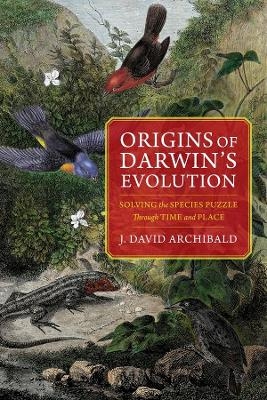
Origins of Darwin's Evolution
Columbia University Press (Verlag)
978-0-231-17685-9 (ISBN)
Historical biogeography—the study of the history of species through both time and place—first convinced Charles Darwin of evolution. This field was so important to Darwin’s initial theories and line of thinking that he said as much in the very first paragraph of On the Origin of Species (1859) and later in his autobiography. His methods included collecting mammalian fossils in South America clearly related to living forms, tracing the geographical distributions of living species across South America, and sampling peculiar fauna of the geologically young Galápagos Archipelago that showed evident affinities to South American forms. Over the years, Darwin collected other evidence in support of evolution, but his historical biogeographical arguments remained paramount, so much so that he devotes three full chapters to this topic in On the Origin of Species.
Discussions of Darwin’s landmark book too often give scant attention to this wealth of evidence, and we still do not fully appreciate its significance in Darwin’s thinking. In Origins of Darwin’s Evolution, J. David Archibald explores this lapse, showing how Darwin first came to the conclusion that, instead of various centers of creation, species had evolved in different regions throughout the world. He also shows that Darwin’s other early passion—geology—proved a more elusive corroboration of evolution. On the Origin of Species has only one chapter dedicated to the rock and fossil record, as it then appeared too incomplete for Darwin’s evidentiary standards. Carefully retracing Darwin’s gathering of evidence and the evolution of his thinking, Origins of Darwin’s Evolution achieves a new understanding of how Darwin crafted his transformative theory.
J. David Archibald is professor emeritus of biology at San Diego State University and curator of mammals at the San Diego State University Museum of Biodiversity. His books include Dinosaur Extinction and the End of an Era: What the Fossils Say (1996) and Aristotle’s Ladder, Darwin’s Tree: The Evolution of Visual Metaphors for Biological Order (2014), both from Columbia University Press, as well as Charles Darwin: A Reference Guide to His Life and Works (2018).
Preface
Acknowledgments
1. Establishing the Fact of Evolution
2. Darwin’s Geological Education
3. The Gravest Objection
4. Marking Time
5. The Immutablists
6. Discovering the Long Dead
7. Relating the Long Dead and Collecting the Recently Living
8. Describing the Long Dead and the Recently Living
9. Private Musings then Shared Sketches
10. Darwin’s Historical Biogeography
Epilogue: What Many Reviewers Missed
References
Index
| Erscheinungsdatum | 30.12.2019 |
|---|---|
| Verlagsort | New York |
| Sprache | englisch |
| Maße | 152 x 229 mm |
| Themenwelt | Naturwissenschaften ► Biologie ► Evolution |
| Naturwissenschaften ► Biologie ► Ökologie / Naturschutz | |
| ISBN-10 | 0-231-17685-6 / 0231176856 |
| ISBN-13 | 978-0-231-17685-9 / 9780231176859 |
| Zustand | Neuware |
| Haben Sie eine Frage zum Produkt? |
aus dem Bereich


